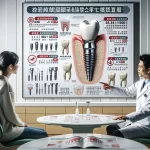Have you ever felt self-conscious about your smile due to damaged, discolored, or misshapen teeth? If so, you’re not alone. Millions of people worldwide struggle with dental imperfections that can impact their confidence and overall quality of life. Fortunately, modern dentistry offers a remarkable solution: dental crowns. These tooth-shaped caps can restore the appearance and functionality of your teeth, transforming your smile from dull to dazzling. In this comprehensive article, we’ll delve into the world of dental crowns, exploring their benefits, the process involved, and the remarkable transformations they can achieve.
The Importance of a Healthy, Confident Smile
Your smile is often the first thing people notice about you, playing a crucial role in making a lasting impression. A beautiful, confident smile can open doors, boost self-esteem, and influence professional and personal relationships. However, when teeth are damaged, discolored, or misshapen, it can be challenging to smile freely without feeling self-conscious.
Dental issues can arise from various factors, including:
- Tooth decay
- Injuries
- Genetics
- Natural aging
These imperfections can profoundly impact an individual’s overall well-being, affecting their confidence, social interactions, and even their ability to enjoy certain foods.
Dental Crowns: A Comprehensive Solution
Dental crowns are tooth-shaped caps designed to cover and protect damaged or decayed teeth. They are custom-made to fit over the remaining tooth structure, restoring its shape, size, strength, and appearance. Crowns can be crafted from various materials, including porcelain, ceramic, metal alloys, or a combination of these materials based on individual needs.
Benefits of Dental Crowns
Dental crowns offer versatility in addressing various dental issues:
- Protecting Weakened Teeth: If a tooth has been severely damaged by decay or trauma, a crown can provide necessary support and protection to prevent further deterioration or potential tooth loss.
- Restoring Broken or Worn Teeth: Over time, teeth can become worn down or cracked due to grinding or clenching. Dental crowns can restore the tooth’s original shape and function.
- Enhancing Cosmetic Appearance: Crowns improve the look of discolored or misshapen teeth for a more uniform smile.
- Supporting Dental Bridges: In cases where a tooth is missing, crowns can anchor a dental bridge securely.
- Covering Dental Implants: After an implant procedure, a crown is placed on top of the implant to restore the appearance and function of the missing tooth.
The Dental Crown Process: A Step-by-Step Guide
Obtaining a dental crown typically involves several steps across two or more visits:
Step 1: Initial Consultation and Examination
During your first visit, your dentist will thoroughly examine your teeth and take X-rays to determine if a dental crown is necessary. This consultation is crucial for assessing your specific dental needs.
Step 2: Tooth Preparation
If a crown is deemed necessary, your dentist will prepare the tooth by removing a small amount of enamel to create space for the crown. This step ensures a proper fit and prevents the crown from appearing bulky or unnatural.
Step 3: Impressions and Shade Selection
Once the tooth is prepared, impressions (molds) will be taken. These impressions will be sent to a dental laboratory where skilled technicians will create a custom-made crown that matches the shape and color of your surrounding teeth.
Step 4: Temporary Crown Placement
While waiting for your permanent crown (typically 1-2 weeks), your dentist will place a temporary crown over the prepared tooth to protect it during this period.
Step 5: Permanent Crown Placement
During your next visit, your dentist will remove the temporary crown and carefully place the permanent crown over your prepared tooth. Adjustments will be made to ensure comfort and proper bite alignment.
Step 6: Follow-up Care
After placing the permanent crown, your dentist will provide care instructions to ensure its longevity. Regular dental check-ups are essential for maintaining both your crowns and overall oral health.
The Transformative Power: Before and After Analysis
Now that we’ve explored the process of obtaining a dental crown let’s examine some remarkable transformations achieved through dental crowns:
Case Study 1: Restoring a Broken Tooth
- Before: A patient presented with a severely cracked front tooth from an accident.
- After: A dental crown was placed over the remaining structure, restoring its shape and function. The patient regained their ability to chew comfortably while boosting their confidence.
Case Study 2: Enhancing Cosmetic Appearance
- Before: A patient was self-conscious about discolored and irregularly shaped teeth.
- After: Multiple crowns were placed on affected teeth creating a uniform smile that significantly enhanced their confidence in social situations.
Case Study 3: Supporting a Dental Bridge
- Before: A patient had a missing tooth affecting chewing ability.
- After: Crowns were placed on adjacent teeth as anchors for a dental bridge effectively replacing the missing tooth while restoring function and aesthetics.
These case studies illustrate how dental crowns address both functional and aesthetic concerns—transforming lives by restoring confidence and improving oral health.
Choosing the Right Dental Crown Material
Selecting the appropriate material for your dental crown is crucial. Your dentist will guide you based on:
- Location of the crown
- Bite patterns
- Personal preferences
Here are common materials used:
- Porcelain Crowns: Ideal for front teeth due to their natural appearance; resistant to staining.
- Ceramic Crowns: Durable; suitable for individuals with metal allergies.
- Metal Alloy Crowns: Known for strength; recommended for molars where aesthetics are less critical.
- Porcelain-Fused-to-Metal (PFM) Crowns: Combine durability with aesthetics for both front and back teeth.
Caring for Your Dental Crowns
To ensure longevity after receiving dental crowns:
- Maintain Good Oral Hygiene: Brush and floss regularly around your crowns.
- Avoid Hard Foods: Steer clear of hard objects that could damage your crowns.
- Wear a Nightguard if Needed: If you grind your teeth at night.
- Attend Regular Check-ups: Routine visits allow monitoring of your crowns’ condition.
By adhering to these guidelines, you can keep your dental crowns in excellent condition for years.
Conclusion: Embrace the Power of a Confident Smile
Dental crowns offer an effective solution for those seeking to enhance their smiles’ appearance and function. From protecting weakened teeth to improving aesthetics, these custom caps can transform lives by restoring confidence.
Understanding the process and materials involved in getting dental crowns empowers you to make informed decisions about your dental health. Embrace this opportunity to reveal your most confident smile—consult with your dentist today about how dental crowns can change your life for the better!
Remember that a confident smile is more than just an aesthetic feature; it’s a powerful asset that can enhance personal interactions and overall well-being. Don’t wait—discover the transformative potential of dental crowns today!
For more information on dental procedures or to find qualified professionals near you, visit American Dental Association or WebMD.
What is the most natural-looking type of dental crown?
All-ceramic or porcelain crowns offer the most natural look, closely mimicking the translucency and color of natural teeth.
How long do dental crowns last?
Dental crowns typically last between 5 and 15 years, depending on the material, oral hygiene, and personal habits. Certain types, like gold crowns, may last even longer.
Are dental crowns painful to get?
The procedure for getting a dental crown is usually not painful, as it is performed under local anesthesia. Some sensitivity or discomfort may be experienced after the procedure, but it typically subsides quickly.
Can a dental crown be done in one day?
Yes, with advancements in dental technology, such as CAD/CAM, some types of crowns can be designed, fabricated, and placed in a single dental visit.
How do I care for my dental crown?
Care for a dental crown involves regular brushing and flossing, avoiding hard and sticky foods, and regular dental check-ups. It’s also important to avoid habits that can damage the crown, like grinding teeth or chewing on hard objects.







